Implementing and Improving CBMZ-MAM3 Chemistry and Aerosol Modules in the Regional Climate Model WRF-CAM5: An Evaluation over the Western US and Eastern North Pacific
Abstract
1. Introduction
- (1)
- The biomass burning emissions are completely ignored for both aerosol-phase (MAM3) and gas-phase (CBMZ) chemistry;
- (2)
- The mechanism that converts VOC to SOC is not included.
2. Methods
2.1. Model
2.2. Simulations
2.3. Observations
2.3.1. MERRA-2 Reanalysis Product
2.3.2. Ground Observations from the EPA, Aerosol Robotic Network, and Interagency Monitoring of Protected Visual Environments
2.3.3. Satellite Observations
2.3.4. MAGIC Ship Campaign
3. Model Improvements and Code Modification
- (a)
- The baseline run with the original WRF-CAM5 coupled with CBMZ-MAM3 (baseline) in the NCAR-released WRF-Chem model. This is a similar setup as developed by Ma et al. [24].
- (b)
- A run including the capability of incorporating biomass burning aerosol emissions in MAM3 (AddingBBaerosol), such as BC and OC.
- (c)
- A run including configuration (b), as well as the capability of incorporating biomass burning emissions of gaseous species in CBMZ (AddingBBgas), such as CO and VOCs.
- (d)
- A run including configuration (c), as well as the conversion mechanism from VOCs to SOC through an intermediate product SOCG (SOC gas; see Section 3.2 for details) (AddingSOC);
- (e)
- A run including configuration (d) and increasing both anthropogenic and biomass burning emissions by three times the inventory levels (TriplingEmission);
- (f)
- A benchmark run with the MOZART-MOSAIC chemistry suite (MOZART-MOSAIC), which is similar to the setup of Wu et al., (2019) [7].
3.1. Accounting for Biomass Burning Emissions in CBMZ-MAM3
3.2. Enabling VOC-to-SOC Conversion
3.3. Modifications to Enhance Emissions
3.4. Modifications to Other Related Modules
4. Results
4.1. Meteorological Evaluation
4.2. Evaluation and Progressive Improvement of the Chemical Output Due to Model Enhancements
4.2.1. Improvements to the AOD
4.2.2. Improvements in Primary Species of BC and CO
4.2.3. Improvements of OC (POC and SOC)
4.3. Comparison with MOZART-MOSAIC
4.4. Off-Coast Aerosols
5. Conclusions
Author Contributions
Funding
Data Availability Statement
Acknowledgments
Conflicts of Interest
Abbreviations
| Long Name | Abbreviation |
| Volatile organic compounds | VOC |
| Secondary organic carbons | SOC |
| Black carbon | BC |
| Organic carbon | OC |
| Carbon monoxide | CO |
| Aerosol optical depth | AOD |
References
- Brasseur, G.P.; Jacob, D.J. Modeling of Atmospheric Chemistry; Cambridge University Press: Cambridge, UK, 2017. [Google Scholar]
- Skamarock, W.C.; Klemp, J.B.; Dudhia, J.; Gill, D.O.; Barker, D.M.; Wang, W.; Powers, J.G. A Description of the Advanced Research WRF Version 2; NCAR Tech (p. 88). Note NCAR/TN-4681STR; National Center for Atmospheric Research: Boulder, CO, USA, 2005. [Google Scholar]
- Grell, G.A.; Peckham, S.E.; Schmitz, R.; McKeen, S.A.; Frost, G.; Skamarock, W.C.; Eder, B. Fully coupled “online” chemistry within the WRF model. Atmos. Environ. 2005, 39, 6957–6975. [Google Scholar] [CrossRef]
- Kumar, R.; Ghude, S.D.; Biswas, M.; Jena, C.; Alessandrini, S.; Debnath, S.; Kulkarni, S.; Sperati, S.; Soni, V.K.; Nanjundiah, R.S.; et al. Enhancing Accuracy of Air Quality and Temperature Forecasts During Paddy Crop Residue Burning Season in Delhi Via Chemical Data Assimilation. J. Geophys. Res. Atmos. 2020, 125, e2020JD033019. [Google Scholar] [CrossRef]
- Kumar, R.; Barth, M.C.; Pfister, G.G.; Delle Monache, L.; Lamarque, J.F.; Archer-Nicholls, S.; Tilmes, S.; Ghude, S.D.; Wiedinmyer, C.; Naja, M.; et al. How will air quality change in South Asia by 2050? J. Geophys. Res. Atmos. 2018, 123, 1840–1864. [Google Scholar] [CrossRef]
- Xu, Y.; Wu, X.; Kumar, R.; Barth, M.; Diao, C.; Gao, M.; Lin, L.; Jones, B.; Meehl, G.A. Substantial Increase in the Joint Occurrence and Human Exposure of Heatwave and High-PM Hazards Over South Asia in the Mid-21st Century. AGU Adv. 2020, 1, e2019AV000103. [Google Scholar] [CrossRef]
- Wu, X.; Xu, Y.; Kumar, R.; Barth, M. Separating Emission and Meteorological Drivers of Mid-21st-Century Air Quality Changes in India Based on Multi year Global-Regional Chemistry-Climate Simulations. J. Geophys. Res. Atmos. 2019, 124, 13420–13438. [Google Scholar] [CrossRef]
- Zhang, Y.; Wen, X.Y.; Jang, C.J. Simulating chemistry–aerosol-cloud–radiation–climate feedbacks over the continental US using the online-coupled Weather Research Forecasting Model with chemistry (WRF/Chem). Atmos. Environ. 2010, 44, 3568–3582. [Google Scholar] [CrossRef]
- Feng, Y.; Kotamarthi, V.R.; Coulter, R.; Zhao, C.; Cadeddu, M. Radiative and thermodynamic responses to aerosol extinction profiles during the pre-monsoon month over South Asia. Atmos. Meas. Tech. 2016, 16, 247–264. [Google Scholar] [CrossRef]
- He, C.; Flanner, M.G.; Chen, F.; Barlage, M.; Liou, K.-N.; Kang, S.; Ming, J.; Qian, Y. Black carbon-induced snow albedo reduction over the Tibetan Plateau: Uncertainties from snow grain shape and aerosol–snow mixing state based on an updated SNICAR model. Atmos. Meas. Tech. 2018, 18, 11507–11527. [Google Scholar] [CrossRef]
- Grell, G.; Freitas, S.R.; Stuefer, M.; Fast, J. Inclusion of biomass burning in WRF-CAM5: Impact of wildfires on weather forecasts. Atmos. Chem. Phys. 2011, 11, 5289–5303. [Google Scholar] [CrossRef]
- Galin, V.Y.; Smyshlyaev, S.P.; Volodin, E.M. Combined chemistry-climate model of the atmosphere. Izv. Atmos. Ocean. Phys. 2007, 43, 399–412. [Google Scholar] [CrossRef]
- Barnard, J.C.; Fast, J.D.; Paredes-Miranda, G.; Arnott, W.P.; Laskin, A. Evaluation of the WRF-CAM5 “Aerosol Chemical to Aerosol Optical Properties” Module using data from the MILAGRO campaign. Atmos. Chem. Phys. 2010, 10, 7325–7340. [Google Scholar] [CrossRef]
- Chin, M.; Rood, R.; Lin, S.-J.; Müller, J.-F.; Thompson, A.M. Atmospheric sulfur cycle simulated in the global model GOCART: Model description and global properties. J. Geophys. Res. Atmos. 2000, 105, 24671–24687. [Google Scholar] [CrossRef]
- Emmons, L.K.; Walters, S.; Hess, P.G.; Lamarque, J.-F.; Pfister, G.G.; Fillmore, D.; Granier, C.; Guenther, A.; Kinnison, D.; Laepple, T.; et al. Description and evaluation of the Model for Ozone and Related chemical Tracers, version 4 (MOZART-4). Geosci. Model Dev. 2010, 3, 43–67. [Google Scholar] [CrossRef]
- Zaveri, R.A.; Easter, R.C.; Fast, J.D.; Peters, L.K. Model for Simulating Aerosol Interactions and Chemistry (MOSAIC). J. Geophys. Res. Atmos. 2008, 113, D13. [Google Scholar] [CrossRef]
- Peckham, S.; Grell, G.A.; McKeen, S.A.; Barth, M.; Pfister, G.; Wiedinmyer, C.; Fast, J.D.; Gustafson, W.I.; Zaveri, R.A.; Easter, R.C.; et al. WRF/Chem Version 3.3 User’s Guide; NOAA Technical Memo; US Department of Commerce, National Oceanic and Atmospheric Administration, Oceanic and Atmospheric Research Laboratories: Boulder, CO, USA, 2012; pp. 1–99. [Google Scholar]
- Phoenix, D.B.; Homeyer, C.R.; Barth, M.C. Sensitivity of simulated convection-driven stratosphere-troposphere exchange in WRF-Chem to the choice of physical and chemical parameterization. Earth Space Sci. 2017, 4, 454–471. [Google Scholar] [CrossRef]
- Shrivastava, M.; Fast, J.; Easter, R.; Gustafson, W.I., Jr.; Zaveri, R.A.; Jimenez, J.L.; Saide, P.; Hodzic, A. Modeling organic aerosols in a megacity: Comparison of simple and complex representations of the volatility basis set approach. Atmos. Chem. Phys. 2011, 11, 6639–6662. [Google Scholar] [CrossRef]
- Emmerson, K.M.; Evans, M.J. Comparison of tropospheric gas-phase chemistry schemes for use within global models. Atmos. Meas. Tech. 2009, 9, 1831–1845. [Google Scholar] [CrossRef]
- Bey, I.; Jacob, D.J.; Yantosca, R.M.; Logan, J.A.; Field, B.D.; Fiore, A.M.; Li, Q.; Liu, H.Y.; Mickley, L.J.; Schultz, M.G. Global modeling of tropospheric chemistry with assimilated meteorology: Model description and evaluation. J. Geophys. Res. Atmos. 2001, 106, 23073–23095. [Google Scholar] [CrossRef]
- Liu, X.; Easter, R.C.; Ghan, S.J.; Zaveri, R.; Rasch, P.; Shi, X.; Lamarque, J.-F.; Gettelman, A.; Morrison, H.; Vitt, F.; et al. Toward a minimal representation of aerosols in climate models: Description and evaluation in the Community Atmosphere Model CAM5. Geosci. Model Dev. 2012, 5, 709–739. [Google Scholar] [CrossRef]
- Peckham, S.E.; Grell, G.A.; McKeen, S.A.; Ahmadov, R.; Wong, K.Y.; Barth, M.; Ghan, S.J. WRF-CAM5 Version 3.8. 1 User’s Guide; National Oceanic and Atmospheric Administration: Wasington, DC, USA, 2017.
- Ma, P.L.; Rasch, P.J.; Fast, J.D.; Easter, R.C.; Gustafson, W.I., Jr.; Liu, X.; Ghan, S.J.; Singh, B. Assessing the CAM5 physics suite in the WRF-CAM5 model: Implementation, resolution sensitivity, and a first evaluation for a regional case study. Geosci. Model Dev. 2014, 7, 755. [Google Scholar] [CrossRef]
- He, J.; Zhang, Y.; Wang, K.; Chen, Y.; Leung, L.R.; Fan, J.; Li, M.; Zheng, B.; Zhang, Q.; Duan, F.; et al. Multi-year application of WRF-CAM5 over East Asia-Part I: Comprehensive evaluation and formation regimes of O3 and PM2.5. Atmos. Environ. 2017, 165, 122–142. [Google Scholar] [CrossRef]
- Zhang, Y.; Zhang, X.; Wang, K.; He, J.; Leung, L.R.; Fan, J.; Nenes, A. Incorporating an advanced aerosol activation pa-rameterization into WRF-CAM5: Model evaluation and parameterization intercomparison. J. Geophys. Res. Atmos. 2015, 120, 6952–6979. [Google Scholar] [CrossRef]
- Painemal, D.; Minnis, P.; Nordeen, M. Aerosol variability, synoptic-scale processes, and their link to the cloud microphysics over the northeast Pacific during MAGIC. J. Geophys. Res. Atmos. 2015, 120, 5122–5139. [Google Scholar] [CrossRef]
- Morrison, H.; Gettelman, A. A New Two-Moment Bulk Stratiform Cloud Microphysics Scheme in the Community Atmosphere Model, Version 3 (CAM3). Part I: Description and Numerical Tests. J. Clim. 2008, 21, 3642–3659. [Google Scholar] [CrossRef]
- Morrison, H.; Thompson, G.; Tatarskii, V. Impact of Cloud Microphysics on the Development of Trailing Stratiform Precipitation in a Simulated Squall Line: Comparison of One- and Two-Moment Schemes. Mon. Weather. Rev. 2009, 137, 991–1007. [Google Scholar] [CrossRef]
- Kanakidou, M.; Seinfeld, J.H.; Pandis, S.N.; Barnes, I.; Dentener, F.J.; Facchini, M.C.; Van Dingenen, R.; Ervens, B.; Nenes, A.; Nielsen, C.J.; et al. Organic aerosol and global climate modelling: A review. Atmos. Chem. Phys. 2005, 5, 1053–1123. [Google Scholar] [CrossRef]
- Tsigaridis, K.; Kanakidou, M. Secondary organic aerosol importance in the future atmosphere. Atmos. Environ. 2007, 41, 4682–4692. [Google Scholar] [CrossRef]
- Camredon, M.; Aumont, B.; Lee-Taylor, J.; Madronich, S. The SOA/VOC/NO x system: An explicit model of secondary organic aerosol formation. Atmos. Chem. Phys. 2007, 7, 5599–5610. [Google Scholar] [CrossRef]
- Skamarock, W.C.; Klemp, J.B. A time-split nonhydrostatic atmospheric model for weather research and forecasting ap-plications. J. Comput. Phys. 2008, 227, 3465–3485. [Google Scholar] [CrossRef]
- Iacono, M.J.; Delamere, J.S.; Mlawer, E.J.; Shephard, M.W.; Clough, S.A.; Collins, W.D. Radiative forcing by long-lived greenhouse gases: Calculations with the AER radiative transfer models. J. Geophys. Res. Atmos. 2008, 113, D13103. [Google Scholar] [CrossRef]
- Tewari, M.; Chen, F.; Wang, W.; Dudhia, J.; LeMone, M.A.; Mitchell, K.; Ek, M.; Gayno, G.; Wegiel, J.; Cuenca, R.H. Implementation and verification of the unified NOAH land surface model in the WRF model. In Proceedings of the 20th Conference on Weather Analysis and Forecasting/16th Conference on Numerical Weather Prediction, Seattle, WA, USA, 10–15 January 2004; American Meteorological Society: Boston, MA, USA, 2004; Volume 1115. [Google Scholar]
- Zaveri, R.A.; Peters, L.K. A new lumped structure photochemical mechanism for large-scale applications. J. Geophys. Res. Atmos. 1999, 104, 30387–30415. [Google Scholar] [CrossRef]
- Park, S.; Bretherton, C.S. The University of Washington Shallow Convection and Moist Turbulence Schemes and Their Impact on Climate Simulations with the Community Atmosphere Model. J. Clim. 2009, 22, 3449–3469. [Google Scholar] [CrossRef]
- Hong, S.-Y.; Noh, Y.; Dudhia, J. A New Vertical Diffusion Package with an Explicit Treatment of Entrainment Processes. Mon. Weather. Rev. 2006, 134, 2318–2341. [Google Scholar] [CrossRef]
- Wild, O.; Zhu, X.; Prather, M.J. Fast-J: Accurate Simulation of In- and Below-Cloud Photolysis in Tropospheric Chemical Models. J. Atmos. Chem. 2000, 37, 245–282. [Google Scholar] [CrossRef]
- Tie, X.; Madronich, S.; Walters, S.; Edwards, D.P.; Ginoux, P.; Mahowald, N.; Zhang, R.; Lou, C.; Brasseur, G. Assessment of the global impact of aerosols on tropospheric oxidants. J. Geophys. Res. Atmos. 2005, 110, D03204. [Google Scholar] [CrossRef]
- Lamarque, J.-F.; Emmons, L.K.; Hess, P.G.; Kinnison, D.E.; Tilmes, S.; Vitt, F.; Heald, C.L.; Holland, E.A.; Lauritzen, P.H.; Neu, J.; et al. CAM-chem: Description and evaluation of interactive atmospheric chemistry in the Community Earth System Model. Geosci. Model Dev. 2012, 5, 369–411. [Google Scholar] [CrossRef]
- US Environmental Protection Agency 2014 National Emissions Inventory, version 2 Technical Support Document. 2018. Available online: https://www.epa.gov/sites/default/files/2018-07/documents/nei2014v2_tsd_05jul2018.pdf (accessed on 20 June 2023).
- Janssens-Maenhout, G.; Crippa, M.; Guizzardi, D.; Dentener, F.; Muntean, M.; Pouliot, G.; Keating, T.; Zhang, Q.; Kurokawa, J.; Wankmüller, R.; et al. HTAP_v2.2: A mosaic of regional and global emission grid maps for 2008 and 2010 to study hemispheric transport of air pollution. Atmos. Meas. Tech. 2015, 15, 11411–11432. [Google Scholar] [CrossRef]
- Wiedinmyer, C.; Akagi, S.K.; Yokelson, R.J.; Emmons, L.K.; Al-Saadi, J.A.; Orlando, J.J.; Soja, A.J. The Fire INventory from NCAR (FINN): A high resolution global model to estimate the emissions from open burning. Geosci. Model Dev. 2011, 4, 625–641. [Google Scholar] [CrossRef]
- Guenther, A.; Karl, T.; Harley, P.; Wiedinmyer, C.; Palmer, P.I.; Geron, C. Estimates of global terrestrial isoprene emissions using MEGAN (Model of Emissions of Gases and Aerosols from Nature). Atmos. Chem. Phys. 2006, 6, 3181–3210, Corrected in Atmos. Chem. Phys. 2006, 6, 3181–3210. [Google Scholar] [CrossRef]
- Gelaro, R.; McCarty, W.; Suárez, M.J.; Todling, R.; Molod, A.; Takacs, L.; Randles, C.A.; Darmenov, A.; Bosilovich, M.G.; Reichle, R.; et al. The Modern-Era Retrospective Analysis for Research and Applications, Version 2 (MERRA-2). J. Clim. 2017, 30, 5419–5454. [Google Scholar] [CrossRef]
- Randles, C.A.; Da Silva, A.M.; Buchard, V.; Colarco, P.R.; Darmenov, A.; Govindaraju, R.; Smirnov, A.; Holben, B.; Ferrare, R.; Hair, J.; et al. The MERRA-2 Aerosol Reanalysis, 1980 Onward. Part I: System Description and Data Assimilation Evaluation. J. Clim. 2017, 30, 6823–6850. [Google Scholar] [CrossRef] [PubMed]
- Aldabash, M.; Balcik, F.B.; Glantz, P. Validation of MODIS C6.1 and MERRA-2 AOD Using AERONET Observations: A Comparative Study over Turkey. Atmosphere 2020, 11, 905. [Google Scholar] [CrossRef]
- Sun, E.; Xu, X.; Che, H.; Tang, Z.; Gui, K.; An, L.; Lu, C.; Shi, G. Variation in MERRA-2 aerosol optical depth and absorption aerosol optical depth over China from 1980 to 2017. J. Atmos. Sol. -Terr. Phys. 2019, 186, 8–19. [Google Scholar] [CrossRef]
- Reichle, R.H.; Draper, C.S.; Liu, Q.; Girotto, M.; Mahanama, S.P.P.; Koster, R.D.; De Lannoy, G.J.M. Assessment of MERRA-2 Land Surface Hydrology Estimates. J. Clim. 2017, 30, 2937–2960. [Google Scholar] [CrossRef]
- EPA. Air Data: Air Quality Data Collected at Outdoor Monitors Across the US. 2017. Available online: https://www.epa.gov/outdoor-air-quality-data (accessed on 20 June 2023).
- Kharol, S.K.; McLinden, C.A.; Sioris, C.E.; Shephard, M.W.; Fioletov, V.; van Donkelaar, A.; Philip, S.; Martin, R.V. OMI satellite observations of decadal changes in ground-level sulfur dioxide over North America. Atmos. Meas. Tech. 2017, 17, 5921–5929. [Google Scholar] [CrossRef]
- Zhang, R.; Wang, Y.; Smeltzer, C.; Qu, H.; Koshak, W.; Boersma, K.F. Comparing OMI-based and EPA AQS in situ NO2 trends: Towards understanding surface NOx emission changes. Atmos. Meas. Tech. 2018, 11, 3955–3967. [Google Scholar] [CrossRef]
- Holben, B.N.; Eck, T.F.; Slutsker, I.; Tanré, D.; Buis, J.P.; Setzer, A.; Vermote, E.; Reagan, J.A.; Kaufman, Y.J.; Nakajima, T.; et al. AERONET—A Federated Instrument Network and Data Archive for Aerosol Characterization. Remote Sens. Environ. 1998, 66, 1–16. [Google Scholar] [CrossRef]
- Dubovik, O.; King, M.D. A flexible inversion algorithm for retrieval of aerosol optical properties from Sun and sky radiance measurements. J. Geophys. Res. Atmos. 2000, 105, 20673–20696. [Google Scholar] [CrossRef]
- Chow, J.C.; Watson, J.G. PM2.5 carbonate concentrations at regionally representative Interagency Monitoring of Protected Visual Environment sites. J. Geophys. Res. Atmos. 2002, 107, ICC 6-1. [Google Scholar] [CrossRef]
- Hyslop, N.P.; White, W.H. An evaluation of interagency monitoring of protected visual environments (IMPROVE) collocated precision and uncertainty estimates. Atmos. Environ. 2008, 42, 2691–2705. [Google Scholar] [CrossRef]
- Adler, R.F.; Huffman, G.J.; Bolvin, D.T.; Curtis, S.; Nelkin, E.J. Tropical Rainfall Distributions Determined Using TRMM Combined with Other Satellite and Rain Gauge Information. J. Appl. Meteorol. 2000, 39, 2007–2023. [Google Scholar] [CrossRef]
- Yamamoto, M.K.; Furuzawa, F.A.; Higuchi, A.; Nakamura, K. Comparison of Diurnal Variations in Precipitation Systems Observed by TRMM PR, TMI, and VIRS. J. Clim. 2008, 21, 4011–4028. [Google Scholar] [CrossRef]
- Josset, D.; Pelon, J.; Protat, A.; Flamant, C. New approach to determine aerosol optical depth from combined CALIPSO and CloudSat ocean surface echoes. Geophys. Res. Lett. 2008, 35, 10. [Google Scholar] [CrossRef]
- Josset, D.; Hou, W.; Pelon, J.; Hu, Y.; Tanelli, S.; Ferrare, R.; Burton, S.; Pascal, N. Ocean and polarization observations from active remote sensing. Atmos. Ocean. Sci. Appl. 2015, 9459, 94590N. [Google Scholar]
- Painemal, D.; Clayton, M.; Ferrare, R.; Burton, S.; Josset, D.; Vaughan, M. Novel aerosol extinction coefficients and lidar ratios over the ocean from CALIPSO–CloudSat: Evaluation and global statistics. Atmos. Meas. Tech. 2019, 12, 2201–2217. [Google Scholar] [CrossRef]
- Winker, D.M.; Vaughan, M.A.; Omar, A.; Hu, Y.; Powell, K.A.; Liu, Z.; Hunt, W.H.; Young, S.A. Overview of the CALIPSO Mission and CALIOP Data Processing Algorithms. J. Atmos. Ocean. Technol. 2009, 26, 2310–2323. [Google Scholar] [CrossRef]
- Lu, X.; Hu, Y.; Trepte, C.; Zeng, S.; Churnside, J.H. Ocean subsurface studies with the CALIPSO spaceborne lidar. J. Geophys. Res. Oceans 2014, 119, 4305–4317. [Google Scholar] [CrossRef]
- Deeter, M.; Emmons, L.K.; Francis, G.L.; Edwards, D.P.; Gille, J.C.; Warner, J.X.; Khattatov, B.; Ziskin, D.; Lamarque, J.-F.; Ho, S.-P.; et al. Operational carbon monoxide retrieval algorithm and selected results for the MOPITT instrument. J. Geophys. Res. Earth Surf. 2003, 108, 4399. [Google Scholar] [CrossRef]
- Worden, H.M.; Deeter, M.N.; Edwards, D.P.; Gille, J.C.; Drummond, J.R.; Nédélec, P. Observations of near-surface carbon monoxide from space using MOPITT multispectral retrievals. J. Geophys. Res. Atmos. 2010, 115, D18314. [Google Scholar] [CrossRef]
- Zhou, X.; Kollias, P.; Lewis, E.R. Clouds, Precipitation, and Marine Boundary Layer Structure during the MAGIC Field Campaign. J. Clim. 2015, 28, 2420–2442. [Google Scholar] [CrossRef]
- Middleton, P.; Stockwell, W.R.; Carter, W.P. Aggregation and analysis of volatile organic compound emissions for regional modeling. Atmos. Environ. Part A. Gen. Top. 1990, 24, 1107–1133. [Google Scholar] [CrossRef]
- Donahue, N.M.; Robinson, A.L.; Stanier, C.O.; Pandis, S.N. Coupled partitioning, dilution, and chemical aging of semi-volatile organics. Environ. Sci. Technol. 2006, 40, 2635–2643. [Google Scholar] [CrossRef] [PubMed]
- Donahue, N.M.; Epstein, S.A.; Pandis, S.N.; Robinson, A.L. A two-dimensional volatility basis set: 1. organic aerosol mixing thermodynamics. Atmos. Chem. Phys. 2011, 11, 3303–3318. [Google Scholar] [CrossRef]
- Fu, T.-M.; Jacob, D.J.; Wittrock, F.; Burrows, J.P.; Vrekoussis, M.; Henze, D.K. Global budgets of atmospheric glyoxal and methylglyoxal, and implications for formation of secondary organic aerosols. J. Geophys. Res. Atmos. 2008, 113, 303. [Google Scholar] [CrossRef]
- Yi, Y.; Zhou, X.; Xue, L.; Wang, W. Air pollution: Formation of brown, lighting-absorbing, secondary organic aerosols by reaction of hydroxyacetone and methylamine. Environ. Chem. Lett. 2018, 16, 1083–1088. [Google Scholar] [CrossRef]
- Kroll, J.H.; Ng, N.L.; Murphy, S.M.; Flagan, R.C.; Seinfeld, J.H. Secondary Organic Aerosol Formation from Isoprene Photooxidation. Environ. Sci. Technol. 2006, 40, 1869–1877. [Google Scholar] [CrossRef] [PubMed]
- Szmigielski, R.; Surratt, J.D.; Vermeylen, R.; Szmigielska, K.; Kroll, J.H.; Ng, N.L.; Murphy, S.M.; Sorooshian, A.; Seinfeld, J.H.; Claeys, M. Characterization of 2-methylglyceric acid oligomers in secondary organic aerosol formed from the photooxidation of isoprene using trimethylsi-lylation and gas chromatography/ion trap mass spectrometry. J. Mass Spectrom. 2007, 42, 101–116. [Google Scholar] [CrossRef] [PubMed]
- Chung, S.H.; Seinfeld, J.H. Global distribution and climate forcing of carbonaceous aerosols. J. Geophys. Res. Atmos. 2002, 107, AAC 14-1–AAC 14-33. [Google Scholar] [CrossRef]
- Henze, D.K.; Hakami, A.; Seinfeld, J.H. Development of the adjoint of GEOS-Chem. Atmos. Meas. Tech. 2007, 7, 2413–2433. [Google Scholar] [CrossRef]
- Carlton, A.G.; Bhave, P.V.; Napelenok, S.L.; Edney, E.O.; Sarwar, G.; Pinder, R.W.; Pouliot, G.A.; Houyoux, M. Model Representation of Secondary Organic Aerosol in CMAQv4.7. Environ. Sci. Technol. 2010, 44, 8553–8560. [Google Scholar] [CrossRef]
- Pye, H.O.T.; D’ambro, E.L.; Lee, B.H.; Schobesberger, S.; Takeuchi, M.; Zhao, Y.; Lopez-Hilfiker, F.; Liu, J.; Shilling, J.E.; Xing, J.; et al. Anthropogenic enhancements to production of highly oxygenated molecules from autoxidation. Proc. Natl. Acad. Sci. USA 2019, 116, 6641–6646. [Google Scholar] [CrossRef] [PubMed]
- Russo, P.N.; Carpenter, D.O. Air Emissions from Natural Gas Facilities in New York State. Int. J. Environ. Res. Public Health 2019, 16, 1591. [Google Scholar] [CrossRef] [PubMed]
- Kim, S.W.; McKeen, S.A.; Frost, G.J.; Lee, S.H.; Trainer, M.; Richter, A.; Angevine, W.M.; Atlas, E.; Bianco, L.; Boersma, K.F.; et al. Evaluations of NO x and highly reactive VOC emission inventories in Texas and their implications for ozone plume simulations during the Texas Air Quality Study 2006. Atmos. Chem. Phys. 2011, 11, 11361–11386. [Google Scholar] [CrossRef]
- Stavrakou, T.; Müller, J.-F.; Bauwens, M.; De Smedt, I.; Lerot, C.; Van Roozendael, M.; Coheur, P.-F.; Clerbaux, C.; Boersma, K.F.; van der A, R.; et al. Substantial Underestimation of Post-Harvest Burning Emissions in the North China Plain Revealed by Multi-Species Space Observations. Sci. Rep. 2016, 6, 32307. [Google Scholar] [CrossRef]
- Flaounas, E.; Kotroni, V.; Lagouvardos, K.; Klose, M.; Flamant, C.; Giannaros, T.M. Sensitivity of the WRF-Chem (V3.6.1) model to different dust emission parametrisation: Assessment in the broader Mediterranean region. Geosci. Model Dev. 2017, 10, 2925–2945. [Google Scholar] [CrossRef]
- Tie, X.; Madronich, S.; Li, G.; Ying, Z.; Zhang, R.; Garcia, A.R.; Lee-Taylor, J.; Liu, Y. Characterizations of chemical oxidants in Mexico City: A regional chemical dynamical model (WRF-Chem) study. Atmos. Environ. 2007, 41, 1989–2008. [Google Scholar] [CrossRef]
- Wang, J.; Yue, Y.; Wang, Y.; Ichoku, C.; Ellison, L.; Zeng, J. Mitigating Satellite-Based Fire Sampling Limitations in Deriving Biomass Burning Emission Rates: Application to WRF-Chem Model Over the Northern sub-Saharan African Region. J. Geophys. Res. Atmos. 2017, 123, 507–528. [Google Scholar] [CrossRef]
- Freitas, S.R.; Longo, K.M.; Chatfield, R.; Latham, D.; Silva Dias, M.A.F.; Andreae, M.O.; Prins, E.; Santos, J.C.; Gielow, R.; Carvalho, J.A., Jr. Including the sub-grid scale plume rise of vegetation fires in low resolution atmospheric transport models. Atmos. Chem. Phys. 2007, 7, 3385–3398. [Google Scholar] [CrossRef]
- Stockwell, W.R.; Middleton, P.; Chang, J.S.; Tang, X. The second generation regional acid deposition model chemical mechanism for regional air quality modeling. J. Geophys. Res. Atmos. 1990, 95, 16343–16367. [Google Scholar] [CrossRef]
- Jaffe, D.; Bertschi, I.; Jaeglé, L.; Novelli, P.; Reid, J.S.; Tanimoto, H.; Vingarzan, R.; Westphal, D.L. Long-range transport of Siberian biomass burning emissions and impact on surface ozone in western North America. Geophys. Res. Lett. 2004, 31, L16106. [Google Scholar] [CrossRef]
- Spracklen, D.V.; Logan, J.A.; Mickley, L.J.; Park, R.J.; Yevich, R.; Westerling, A.L.; Jaffe, D.A. Wildfires drive interannual variability of organic carbon aerosol in the western U.S. in summer. Geophys. Res. Lett. 2007, 34, L16816. [Google Scholar] [CrossRef]
- Dennison, P.E.; Brewer, S.C.; Arnold, J.D.; Moritz, M.A. Large wildfire trends in the western United States, 1984–2011. Geophys. Res. Lett. 2014, 41, 2928–2933. [Google Scholar] [CrossRef]
- Caldwell, P.M.; Mametjanov, A.; Tang, Q.; Van Roekel, L.P.; Golaz, J.; Lin, W.; Bader, D.C.; Keen, N.D.; Feng, Y.; Jacob, R.; et al. The DOE E3SM Coupled Model Version 1: Description and Results at High Resolution. J. Adv. Model. Earth Syst. 2019, 11, 4095–4146. [Google Scholar] [CrossRef]
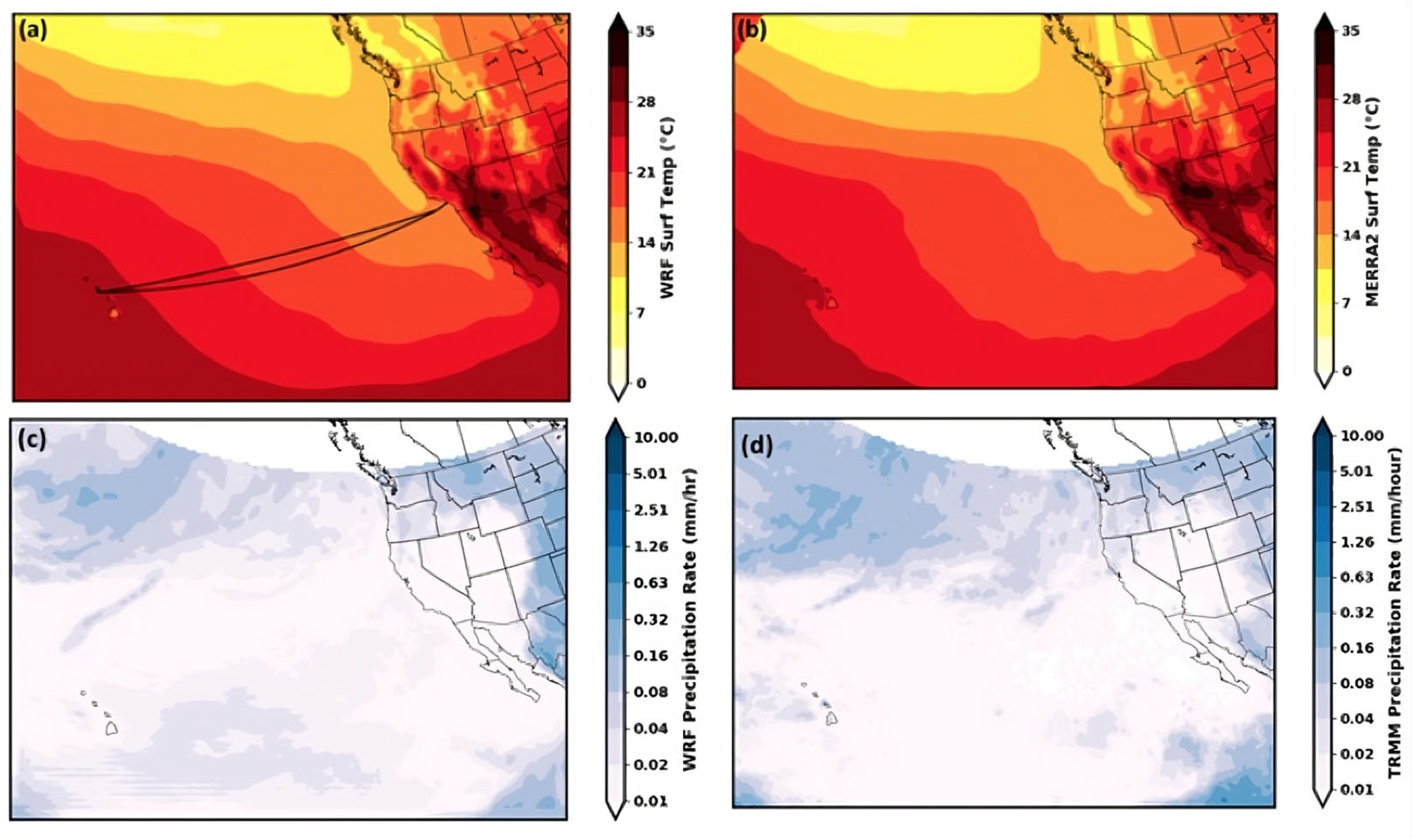
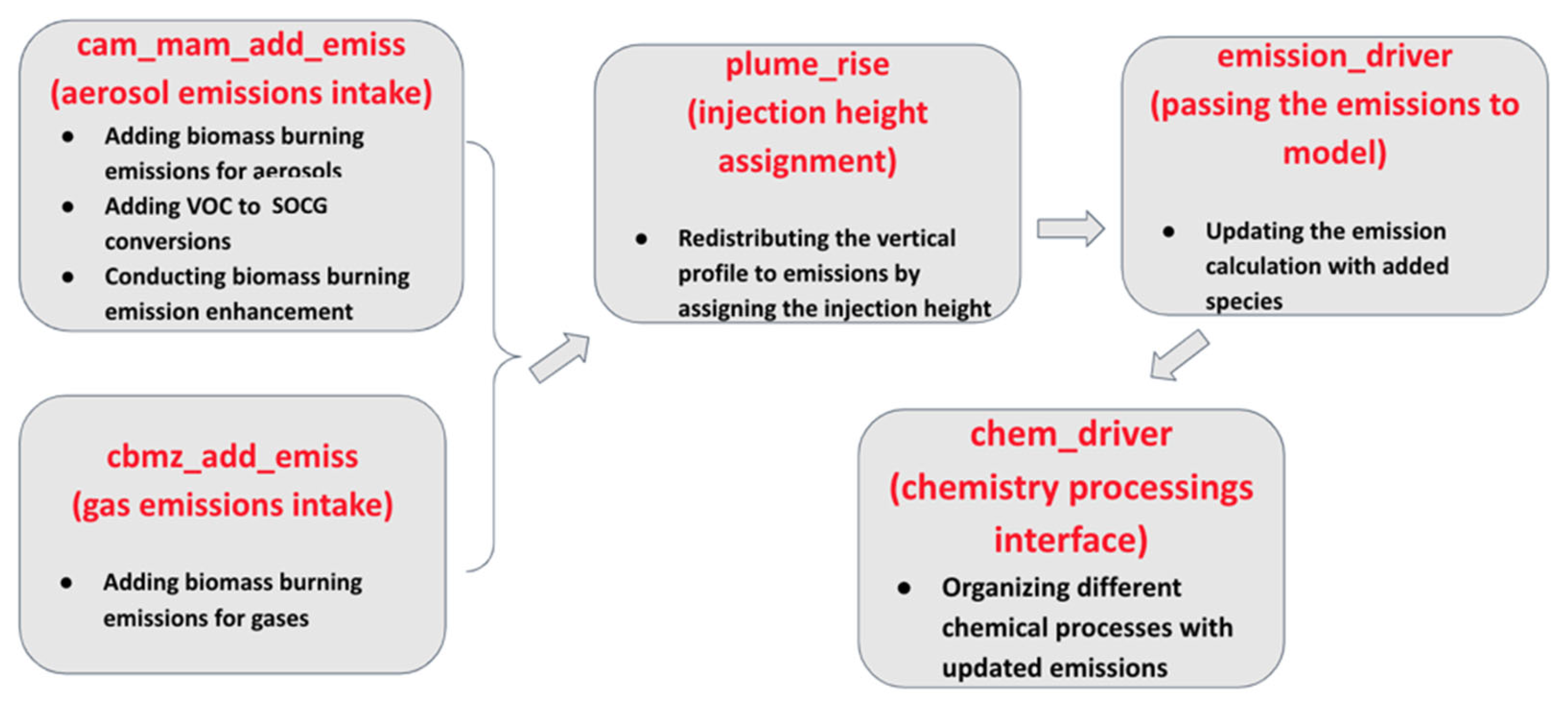

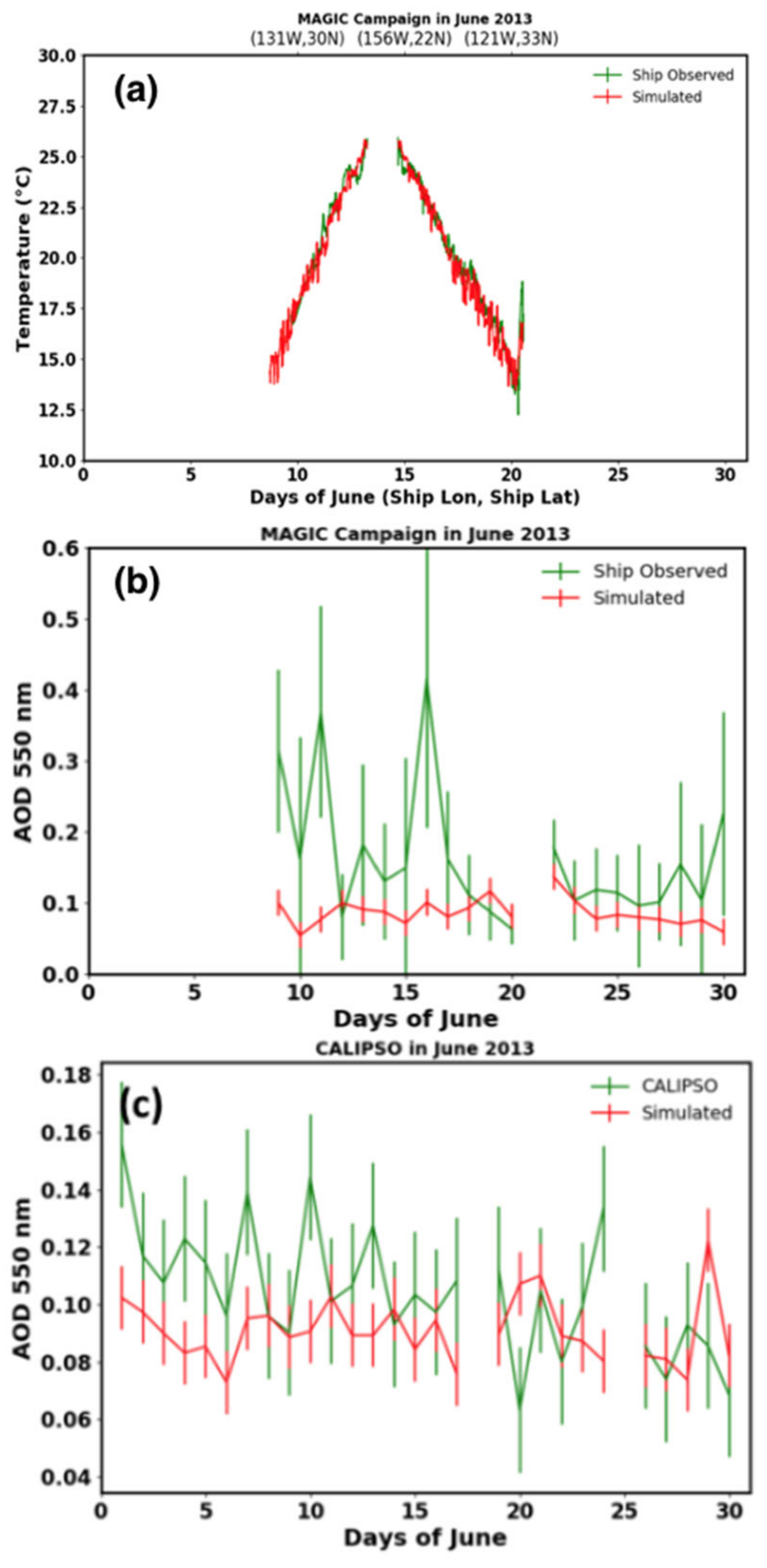
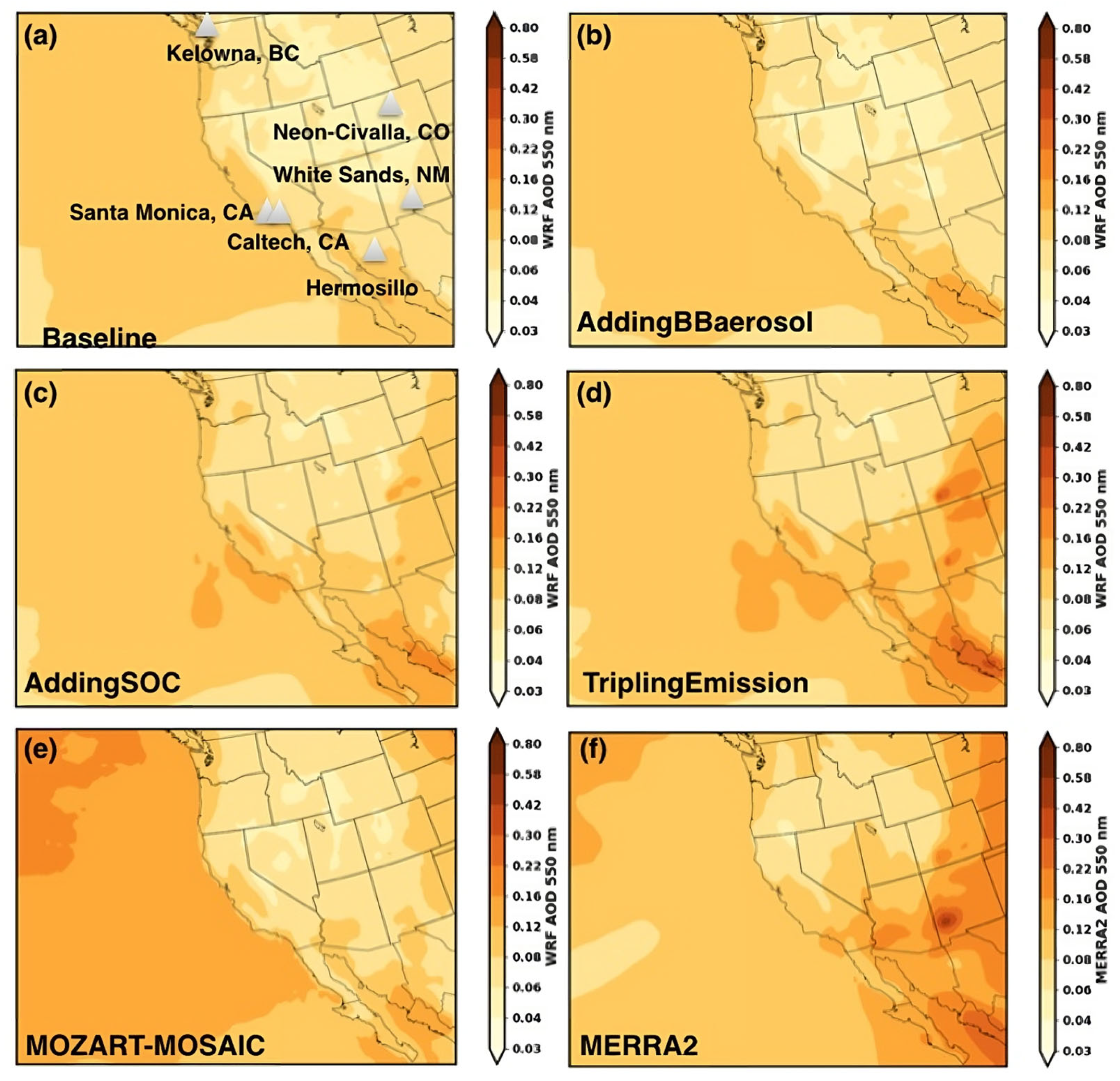
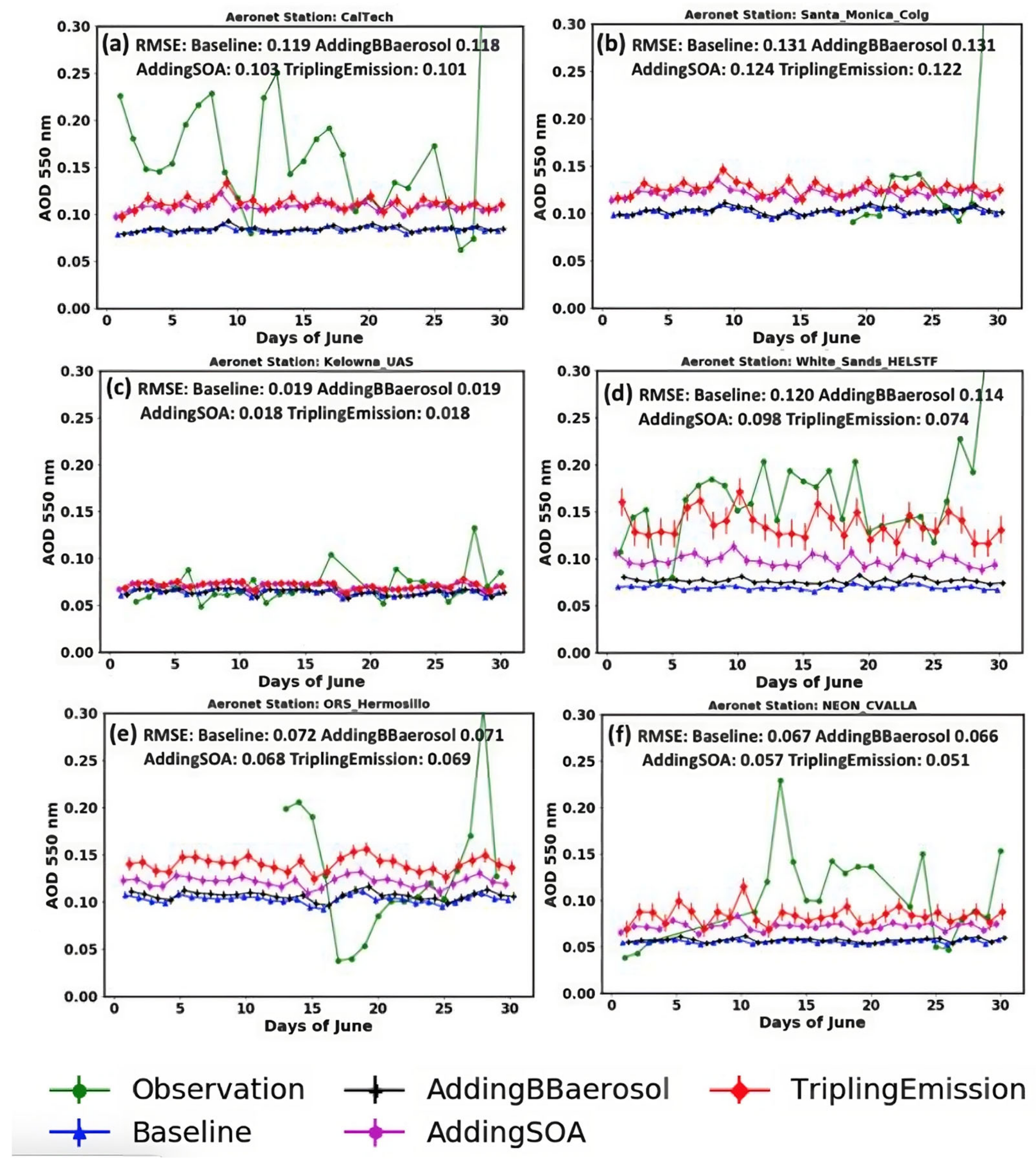

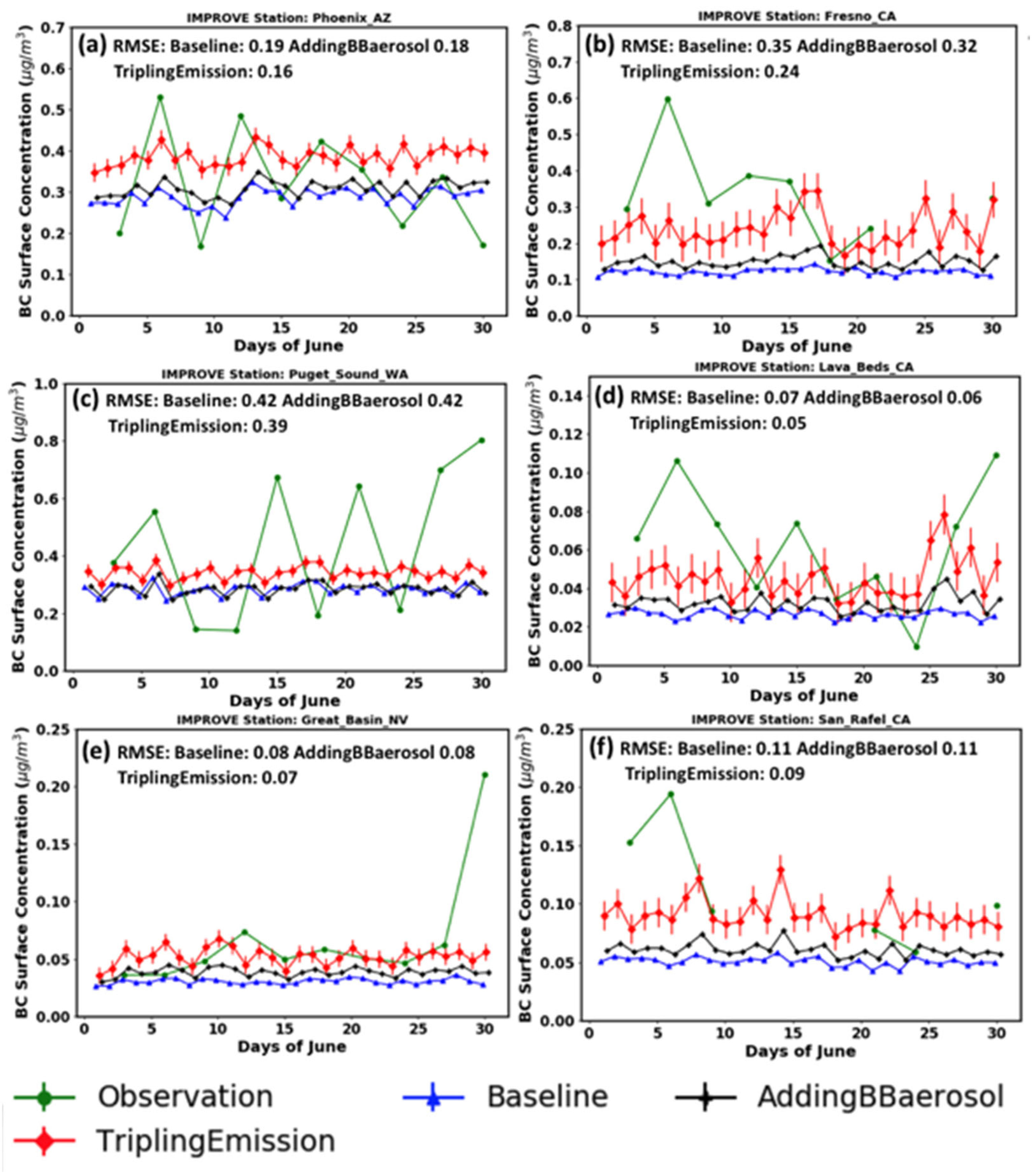
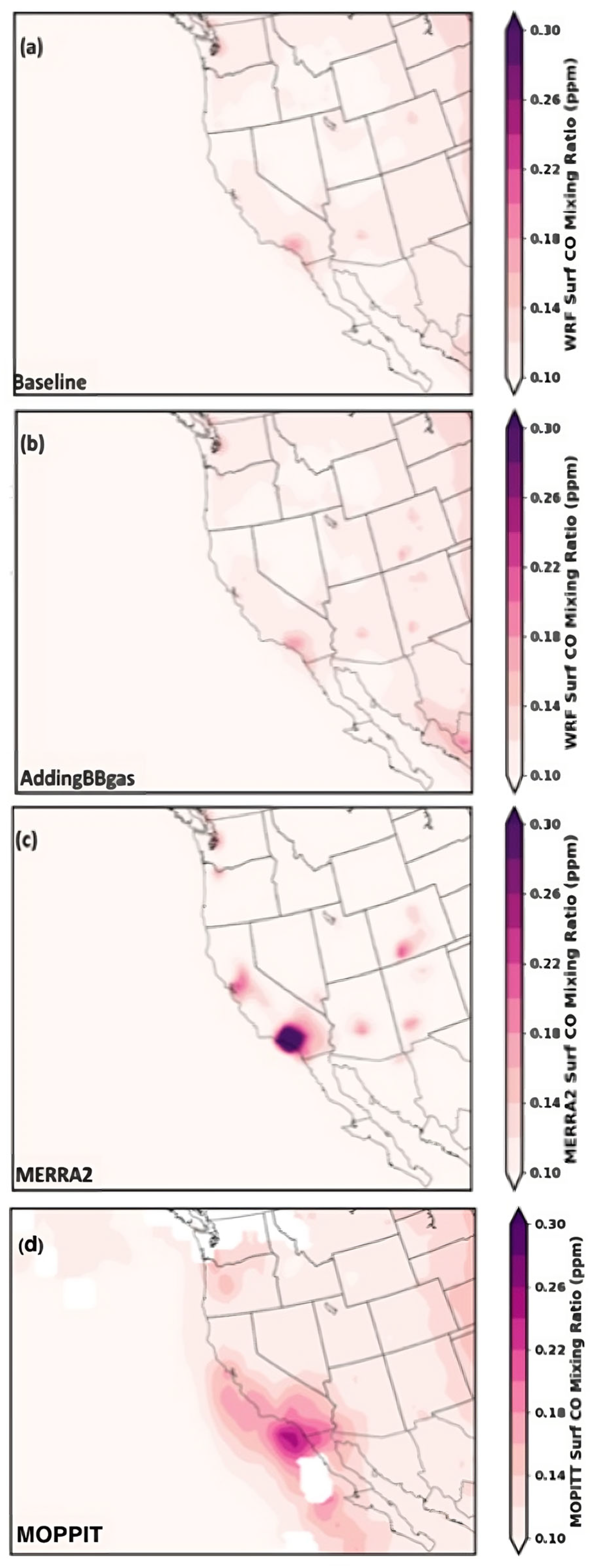
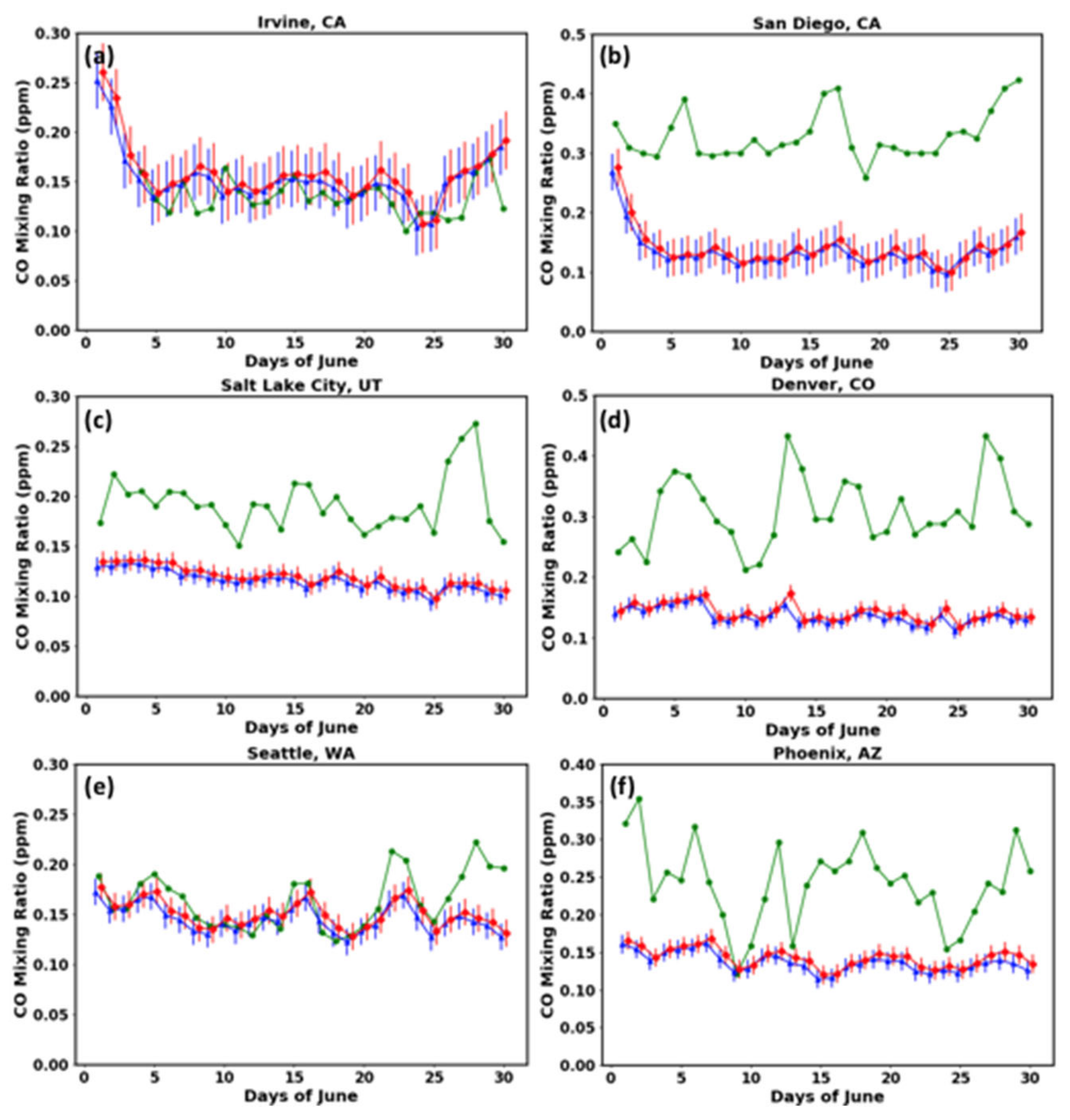

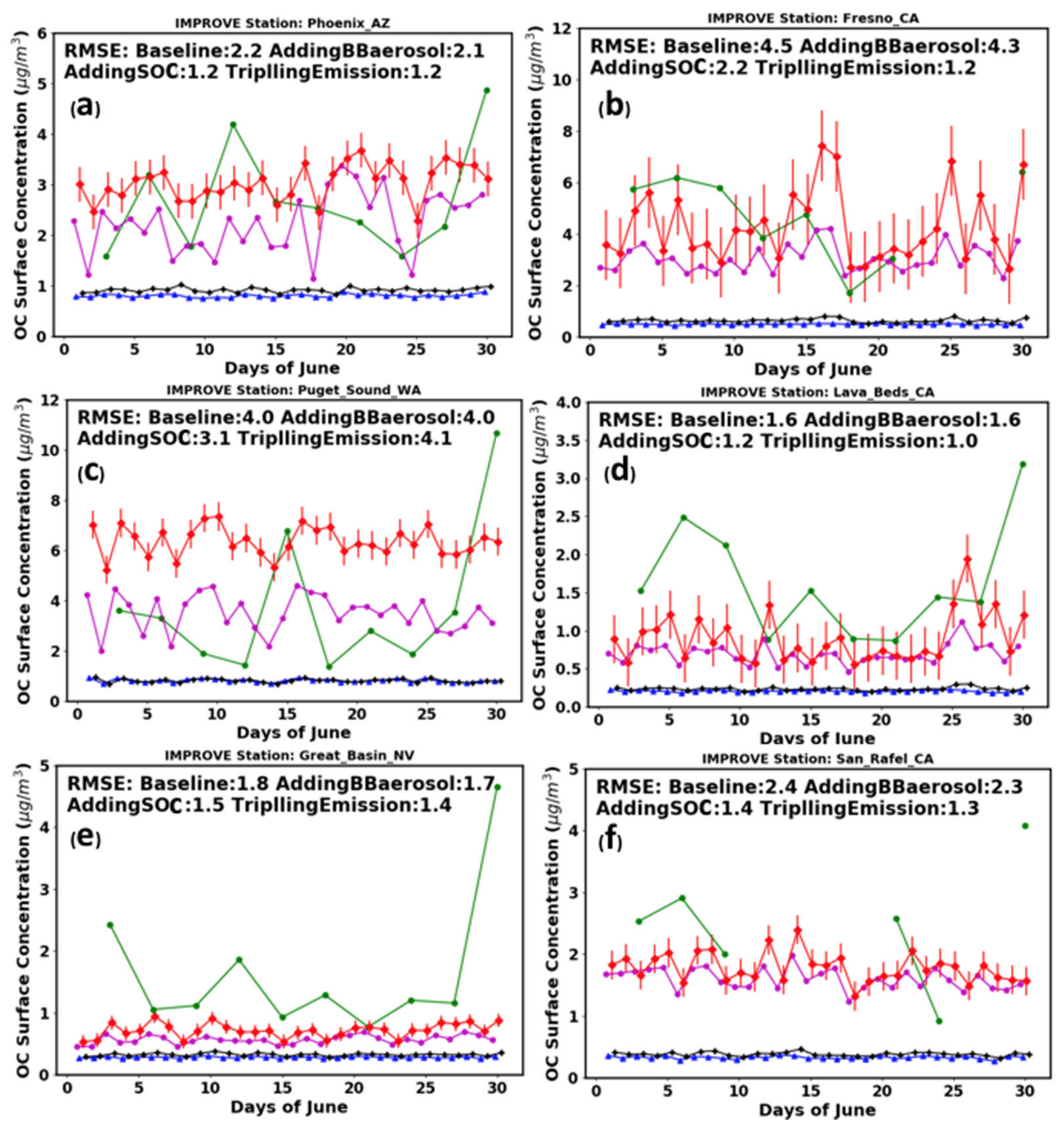
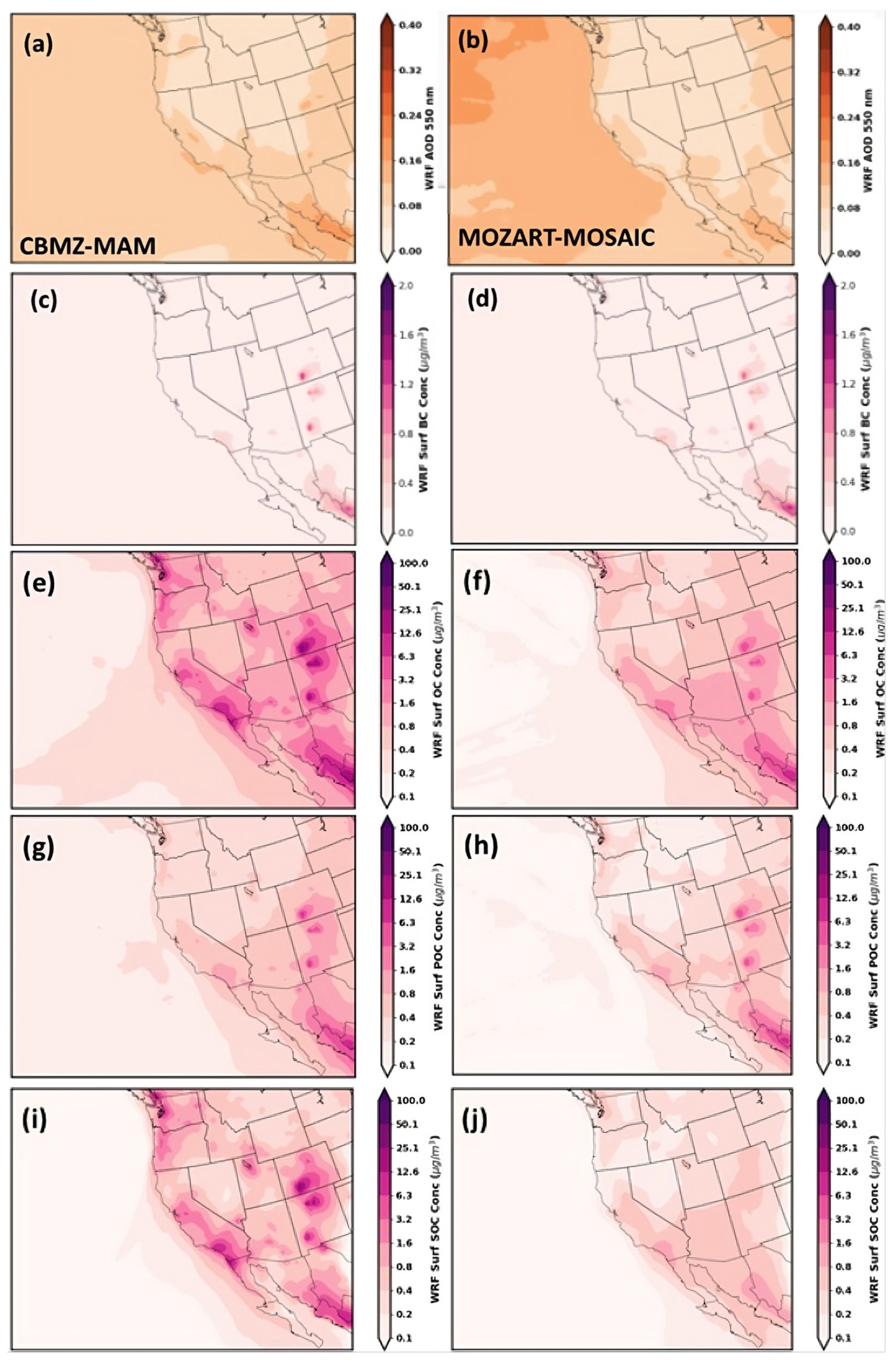
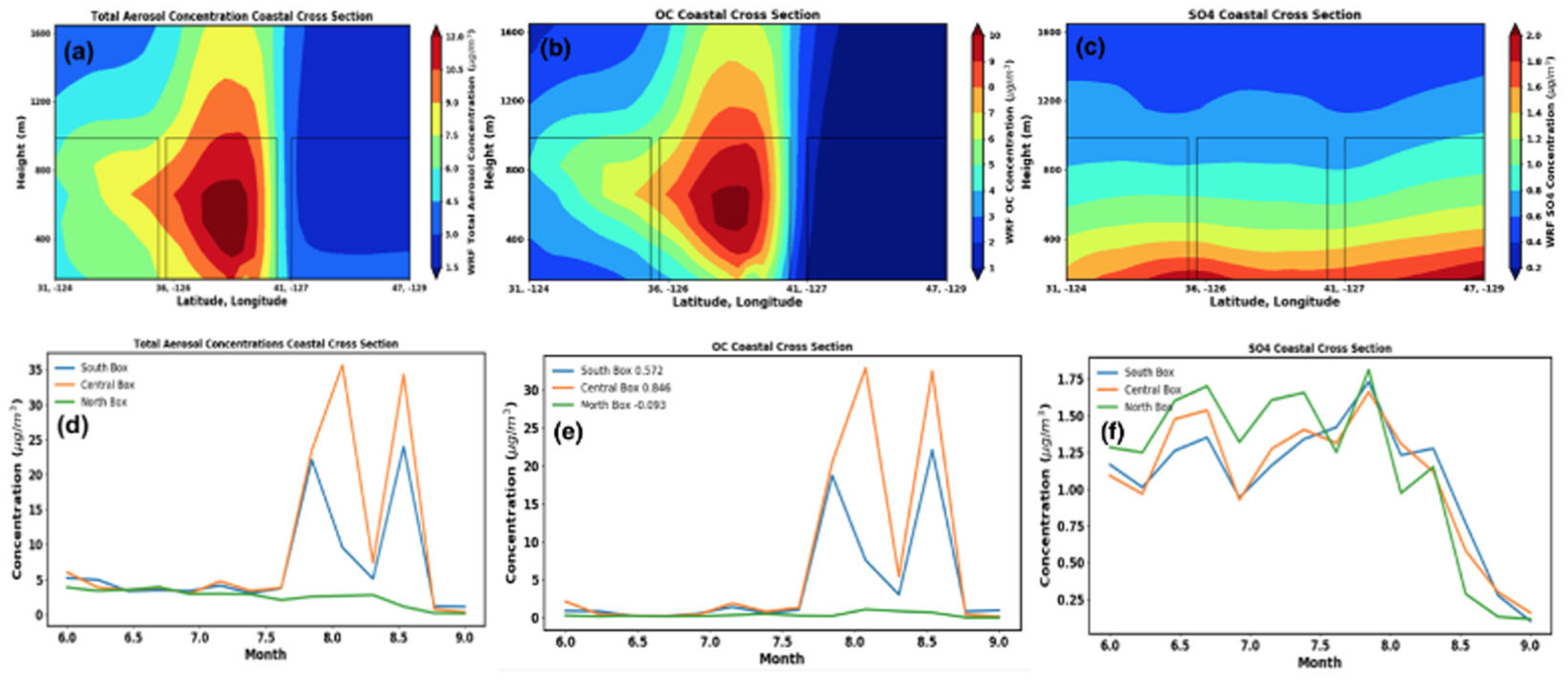

| Physical or Chemical Scheme | WRF-CAM5 with CBMZ-MAM3 | WRF-Chem with MOZART-MOSAIC |
|---|---|---|
| Gas-phase chemistry | CBMZ | MOZART |
| Aerosol | MAM3 | MOSAIC (4-bins) |
| Photolysis | Fast-J | Madronich F-TUV |
| Emissions Read-in Scheme | RADM2 gas emissions to CBMZ with MAM3 aerosols | MOZART + aerosol emissions |
| Microphysics | CAM5: Morrison and Gettleman (Morrison et al., 2008 [28]) | Morrison double-moment (Morrison et al., 2009 [29]) |
| Cumulus | CAM5: Zhang–McFarlane | Grell–Freitas |
| Planetary Boundary Layer | CAM5: University of Washington | Yonsei University |
| Data Source | Data Source Links | Variables Provided |
|---|---|---|
| Aerosol robotic network (AERONET) | https://aeronet.gsfc.nasa.gov/ accessed on 20 June 2023 | AOD |
| Interagency monitoring of protected visual environments (IMPROVE) | http://vista.cira.colostate.edu/Improve/ accessed on 20 June 2023 | surface concentrations of BC and OC |
| Environmental Protection Agency (EPA) | https://www.epa.gov/aqs accessed on 20 June 2023 | surface temperatures; surface concentrations of CO |
| The modern-era retrospective analysis for research and applications, version 2 (MERRA-2) | https://gmao.gsfc.nasa.gov/reanalysis/MERRA-2/ accessed on 20 June 2023 | surface temperatures; surface concentrations of BC, CO, and OC; AOD |
| Tropical rainfall measuring mission (TRMM) | https://gpm.nasa.gov/data/directory accessed on 20 June 2023 | precipitation |
| Cloud–aerosol lidar and infrared pathfinder satellite observations (CALIPSO) based on SODA algorithm | https://www-calipso.larc.nasa.gov/ accessed on 20 June 2023 | AOD |
| MAGIC ship campaign for June 2013 | https://www.arm.gov/research/campaigns/amf2012magic accessed on 20 June 2023 | surface temperatures; AOD |
| Configuration | Short Name | Description |
|---|---|---|
| a | Baseline | Baseline configuration (Ma et al., 2014 [24]) |
| b | AddingBBaerosol | Aerosols from biomass burning emissions added to MAM3 |
| c | AddingBBgas | Gases from biomass burning emissions added to CBMZ |
| d | AddingSOC | VOC-to-SOC conversions added |
| e | TriplingEmission | 3× anthropogenic and biomass burning emissions |
| f | MOZART-MOSAIC | The MOZART-MOSAIC run (Wu et al., 2019 [7]) |
Disclaimer/Publisher’s Note: The statements, opinions and data contained in all publications are solely those of the individual author(s) and contributor(s) and not of MDPI and/or the editor(s). MDPI and/or the editor(s) disclaim responsibility for any injury to people or property resulting from any ideas, methods, instructions or products referred to in the content. |
© 2023 by the authors. Licensee MDPI, Basel, Switzerland. This article is an open access article distributed under the terms and conditions of the Creative Commons Attribution (CC BY) license (https://creativecommons.org/licenses/by/4.0/).
Share and Cite
Wu, X.; Feng, Y.; He, C.; Kumar, R.; Ge, C.; Painemal, D.; Xu, Y. Implementing and Improving CBMZ-MAM3 Chemistry and Aerosol Modules in the Regional Climate Model WRF-CAM5: An Evaluation over the Western US and Eastern North Pacific. Atmosphere 2023, 14, 1122. https://doi.org/10.3390/atmos14071122
Wu X, Feng Y, He C, Kumar R, Ge C, Painemal D, Xu Y. Implementing and Improving CBMZ-MAM3 Chemistry and Aerosol Modules in the Regional Climate Model WRF-CAM5: An Evaluation over the Western US and Eastern North Pacific. Atmosphere. 2023; 14(7):1122. https://doi.org/10.3390/atmos14071122
Chicago/Turabian StyleWu, Xiaokang, Yan Feng, Cenlin He, Rajesh Kumar, Cui Ge, David Painemal, and Yangyang Xu. 2023. "Implementing and Improving CBMZ-MAM3 Chemistry and Aerosol Modules in the Regional Climate Model WRF-CAM5: An Evaluation over the Western US and Eastern North Pacific" Atmosphere 14, no. 7: 1122. https://doi.org/10.3390/atmos14071122
APA StyleWu, X., Feng, Y., He, C., Kumar, R., Ge, C., Painemal, D., & Xu, Y. (2023). Implementing and Improving CBMZ-MAM3 Chemistry and Aerosol Modules in the Regional Climate Model WRF-CAM5: An Evaluation over the Western US and Eastern North Pacific. Atmosphere, 14(7), 1122. https://doi.org/10.3390/atmos14071122







